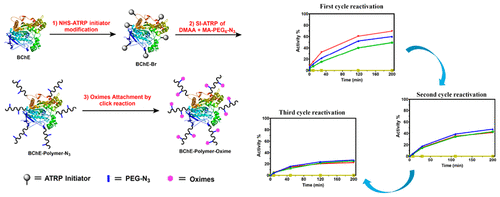当前位置:
X-MOL 学术
›
Biomacromolecules
›
论文详情
Our official English website, www.x-mol.net, welcomes your
feedback! (Note: you will need to create a separate account there.)
Catalytic Detoxification of Organophosphorus Nerve Agents by Butyrylcholinesterase-Polymer-Oxime Bioscavengers.
Biomacromolecules ( IF 5.5 ) Pub Date : 2020-07-31 , DOI: 10.1021/acs.biomac.0c00959 Libin Zhang 1 , Hironobu Murata 1 , Gabriel Amitai 2 , Paige N Smith 3 , Krzysztof Matyjaszewski 1, 4, 5 , Alan J Russell 1, 4, 5
Biomacromolecules ( IF 5.5 ) Pub Date : 2020-07-31 , DOI: 10.1021/acs.biomac.0c00959 Libin Zhang 1 , Hironobu Murata 1 , Gabriel Amitai 2 , Paige N Smith 3 , Krzysztof Matyjaszewski 1, 4, 5 , Alan J Russell 1, 4, 5
Affiliation

|
Organophosphorus nerve agents (OPNAs), used in chemical warfare, irreversibly inhibit essential cholinesterases (ChEs) in the cholinergic neurotransmission system. Several potent nucleophilic oximes have been approved for the treatment of acute poisoning by OPNAs, but they are rapidly cleared from blood circulation. Butyrylcholinesterase (BChE) stoichiometrically binds nerve agents, but because the molecular weight of a nerve agent is about 500-fold less than the enzyme, the bioscavenger has had limited utility. We synthesized BChE-polymer-oxime conjugates using atom transfer radical polymerization (ATRP) and azide–alkyne “click” chemistry. The activity of the BChE-polymer-oxime conjugates was dependent on the degree of oxime loading within the copolymer side chains. The covalent modification of oxime-containing copolymers prolonged the activity of BChE in the presence of the VX- and cyclosarin-fluorogenic analogues EMP-MeCyC and CMP-MeCyC, respectively. After complete inactivation by VX and cyclosarin fluorogenic analogues, the conjugates demonstrated efficient self-reactivation of up to 80% within 3–6 h. Repeated inhibition and high-level self-reactivation assays revealed that the BChE-polymer-oxime conjugates were excellent reactivators of OPNA-inhibited BChE. Recurring self-reactivation of BChE-polymer-oxime conjugates following repeated BChE inhibition by fluorogenic OPNAs (Flu-OPNAs) opens the door to developing the next generation of nerve agent “catalytic” bioscavengers.
中文翻译:

丁酰胆碱酯酶-聚合物-肟生物清除剂对有机磷神经剂的催化解毒作用。
化学战中使用的有机磷神经毒剂(OPNAs)不可逆地抑制胆碱能神经传递系统中的必需胆碱酯酶(ChEs)。几种有效的亲核肟已被OPNA批准用于治疗急性中毒,但已迅速从血液循环中清除。丁酰胆碱酯酶(BChE)在化学计量上与神经毒剂结合,但由于神经毒剂的分子量比该酶小约500倍,因此该生物清除剂的用途有限。我们使用原子转移自由基聚合(ATRP)和叠氮化物-炔烃“点击”化学方法合成了BChE-聚合物-肟共轭物。BChE-聚合物-肟共轭物的活性取决于共聚物侧链中肟的负载程度。含肟共聚物的共价修饰分别延长了VX和环沙林荧光类似物EMP-MeCyC和CMP-MeCyC的存在下BChE的活性。在被VX和环沙林荧光类似物完全灭活后,结合物在3–6 h内表现出高达80%的有效自我激活。重复的抑制作用和高水平的自我再激活实验表明,BChE-聚合物-肟共轭物是OPNA抑制的BChE的出色激活剂。在反复受到荧光性OPNA(Flu-OPNAs)抑制BChE的作用后,BChE-聚合物-肟共轭物的反复自我活化为开发下一代神经毒剂“催化”生物清除剂打开了大门。在被VX和环沙林荧光类似物完全灭活后,结合物在3–6 h内表现出高达80%的有效自我激活。重复的抑制和高水平的自我再激活实验表明,BChE-聚合物-肟共轭物是OPNA抑制的BChE的出色激活剂。在反复受到荧光性OPNA(Flu-OPNAs)抑制BChE的作用后,BChE-聚合物-肟共轭物的反复自我活化为开发下一代神经毒剂“催化”生物清除剂打开了大门。在被VX和环沙林荧光类似物完全灭活后,结合物在3–6 h内表现出高达80%的有效自我激活。重复的抑制和高水平的自我再激活实验表明,BChE-聚合物-肟共轭物是OPNA抑制的BChE的出色激活剂。在反复受到荧光性OPNA(Flu-OPNAs)抑制BChE的作用后,BChE-聚合物-肟共轭物的反复自我活化为开发下一代神经毒剂“催化”生物清除剂打开了大门。
更新日期:2020-09-14
中文翻译:

丁酰胆碱酯酶-聚合物-肟生物清除剂对有机磷神经剂的催化解毒作用。
化学战中使用的有机磷神经毒剂(OPNAs)不可逆地抑制胆碱能神经传递系统中的必需胆碱酯酶(ChEs)。几种有效的亲核肟已被OPNA批准用于治疗急性中毒,但已迅速从血液循环中清除。丁酰胆碱酯酶(BChE)在化学计量上与神经毒剂结合,但由于神经毒剂的分子量比该酶小约500倍,因此该生物清除剂的用途有限。我们使用原子转移自由基聚合(ATRP)和叠氮化物-炔烃“点击”化学方法合成了BChE-聚合物-肟共轭物。BChE-聚合物-肟共轭物的活性取决于共聚物侧链中肟的负载程度。含肟共聚物的共价修饰分别延长了VX和环沙林荧光类似物EMP-MeCyC和CMP-MeCyC的存在下BChE的活性。在被VX和环沙林荧光类似物完全灭活后,结合物在3–6 h内表现出高达80%的有效自我激活。重复的抑制作用和高水平的自我再激活实验表明,BChE-聚合物-肟共轭物是OPNA抑制的BChE的出色激活剂。在反复受到荧光性OPNA(Flu-OPNAs)抑制BChE的作用后,BChE-聚合物-肟共轭物的反复自我活化为开发下一代神经毒剂“催化”生物清除剂打开了大门。在被VX和环沙林荧光类似物完全灭活后,结合物在3–6 h内表现出高达80%的有效自我激活。重复的抑制和高水平的自我再激活实验表明,BChE-聚合物-肟共轭物是OPNA抑制的BChE的出色激活剂。在反复受到荧光性OPNA(Flu-OPNAs)抑制BChE的作用后,BChE-聚合物-肟共轭物的反复自我活化为开发下一代神经毒剂“催化”生物清除剂打开了大门。在被VX和环沙林荧光类似物完全灭活后,结合物在3–6 h内表现出高达80%的有效自我激活。重复的抑制和高水平的自我再激活实验表明,BChE-聚合物-肟共轭物是OPNA抑制的BChE的出色激活剂。在反复受到荧光性OPNA(Flu-OPNAs)抑制BChE的作用后,BChE-聚合物-肟共轭物的反复自我活化为开发下一代神经毒剂“催化”生物清除剂打开了大门。











































 京公网安备 11010802027423号
京公网安备 11010802027423号